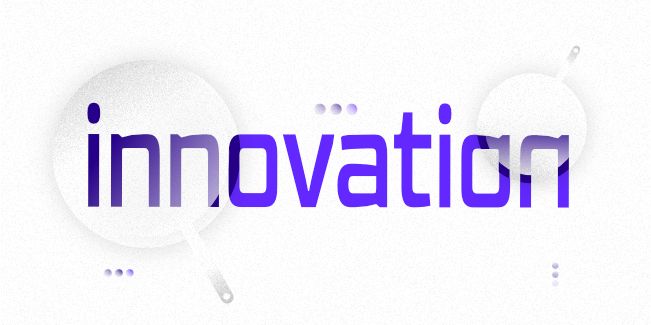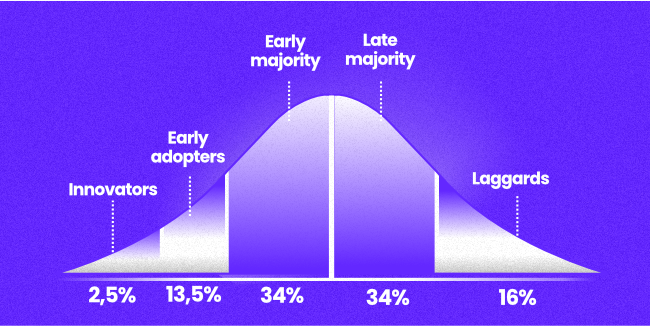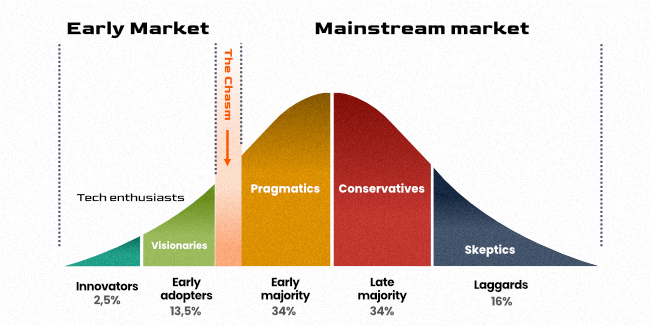startup
sdlc
technologies
Technology Adoption Curve: Revolution Unveiled!

The influence of modern technologies on the development of the contemporary world is indisputable. The knowledge that we can gain thanks to technologies causes the development of civilization, various markets for the industry, and even medicine. Technology develops so quickly because of the progress we, as humankind, made and the development of offshore outsourcing services.
As a software development company, we have been fully aware for many years that technology is to serve people. That is why we do everything in our power to ensure that the products we create reach the widest possible group of users. It requires us to know not only about the Software Development Life Cycle but also about the adoption process of a new product by various user groups.
What is Technology Adoption?
The technology adoption lifecycle is a sociological model that describes the adoption process of a new product or innovation according to specific adoptive groups' demographic and psychological characteristics. Geoffrey Moore created the adoption life foundations, and after 40 years, they were updated by Everett Rogers, developing the theory of diffusion of innovations ("Diffusion Innovation"). This model assumes that we have five recipients with different needs and expectations regarding the product when introducing new technologies. They are Innovators, Early Adopters, Early Majority, Late Majority, and Laggards.

Technology Adoption Curve
Paradoxically, introducing innovative technology is not easy and faces many obstacles. It is because enterprises do not consider the different adopters' categories among their potential customers and users. They treat everyone equally, resulting in resistance, an unsatisfactory level of performance, and a low return on investment.
For the implementation of new technologies to be effective, it is crucial to understand different groups of people, which will allow you to build a strategy that will encourage users to reach for innovation as quickly as possible. Why is it so important? Because every time you implement new technology, you need to convince each of the five user types to do so.
According to Rogers' theory, the technology adoption curve describes how different people react to a new product. If we were to graph these groups, we’d see the standard bell shape curve.

What are the 5 adopter categories?
Innovators
Constitute a small part of the total market: around 2.5%. They are enthusiastic about new technologies. They look for them themselves; they are willing to test them and are ready to take risks associated with them. Innovators are usually young people with a high social and financial status. They love trying new things and may even encourage others to try a new app or tool.
Early Adopters
It is the second fastest category of individuals who adopt a novation. They account for approx. 13.5% of the population. They are often referred to as visionaries. They are not professionally involved in technology, but they see new applications and opportunities for innovation. Time is of the essence for them, they act in a hurry, and they want to see results quickly. As a result, they find an exciting novation for the new technology. Like Innovators, they are eager to approach technological novelties but are more cautious of new trends due to their role as change leaders, which they do not want to lose. Early adopters are typically younger, have a higher social status, have more financial lucidity, advanced education, and are more socially forward than late adopters.
It is worth involving these two groups of users - Innovators and Early Adopters - when implementing new solutions due to their natural curiosity towards new technologies and willingness to test solutions.
Early Majority
They make up 34% of the population. Individuals in this category adopt a novation after a varying degree of time. This time of adoption is significantly longer than the innovators and early adopters. For the "Early Majority" group, the efficiency and practical benefits of the new solution are more important than the popularity or innovation of the product. People from this group are usually skeptical about change, and they need help and support before they are willing to get used to the change or get involved in a new process. They are also called pragmatists, so it is best to convince them by showing the advantages and benefits of the new product.
Late Majority
They are skeptics for whom the technology adoption is only possible after others people have tested it. They choose brands with a stable position on the market, and they only price products after they reach maturity. This team takes references from others and requires access to maintenance services. These people are very cautious and wary of any novation, and change is a lengthy procedure. The late majority makes up 34 percent.

Laggards
The laggards (16%) are the last at the technology implementation curve. They are the most prominent skeptics - they are the slowest to get used to the new conditions. They only adapt to change when they are forced to, and everyone else has already done so. If they could, they wouldn't change anything.
Retarders tend to be "tradition" centered, possibly lowest in society, least liquid, are the oldest of all other adopters, communicate only with family and close friends, have little or no opinion-forming leadership.
Crossing the Chasm
"Crossing the chasm" is where the innovation has been accepted by Enthusiasts, but not yet by the Pragmatists. It is the most critical moment in the adoption process. Both groups on the left side of the gap expect innovation and efficiency. Meanwhile, those on the right - focus on comfort and reliability. Their expectations are radically different.
Crossing the chasm is difficult but not impossible. The key is to meet the needs and expectations of the pragmatic majority at the right moment. It means that your innovations must be fully functional and, of course, must not contain bugs. It doesn't have to include a million features, but it does have to have every functionality promised. In the software development industry, we call such a product an MVP (Minimum Viable Product). If you want to know more, check out our article on this topic.
Conclusion
In-depth knowledge of different groups of your users allows you to properly plan the process of introducing a product to the market. Contrary to appearances, this is not an easy task, so it is good to use the services of the best product development company, which has extensive experience and enormous knowledge. In our next article, we suggest how to choose a proven software development partner wisely. The right decision will guarantee the de facto success of your product. Good luck!